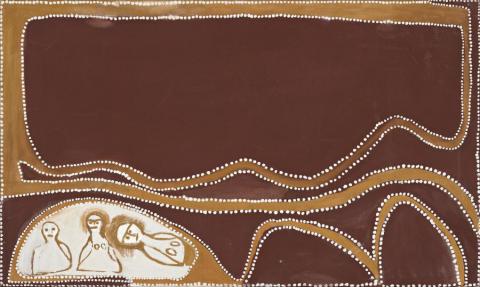LIGHTNING STORM AT ROSEWOOD, 1991
ROVER THOMAS (JOOLAMA)
natural earth pigments with natural binder on canvas
60.0 x 100.0 cm
inscribed verso: artist's name, date and title
Mary Macha, Perth
Private collection, Northern Territory
Rover Thomas not only lived through a significant and tumultuous period of the history of the Kimberley but has himself become a part of the story of the country, a story expressed in his art. In Rover Thomas's paintings, the land becomes the subject, theme and witness of the events on both the epic supernatural and intimate human scales.
Rover Thomas has developed a personal style which is deeply rooted in his knowledge of the traditional pictorial conventions of the region. His works incorporate all the traits of East Kimberly rock art and the more ephemeral body painting traditions. His landscapes rendered in broad areas of natural pigments and gums appear both in plan views and side-on, often simultaneously. Shapes are often delineated by white dots, a convention found also in the desert. The landscapes relate to tracts of country, with specific indicators to sites of either traditional or historic importance, and twentieth-century iconography is incorporated easily when necessary.
Rover Thomas began to paint in the mid 1970s after working for more than thirty years as a stockman and labourer in his home country of the Great Sandy and Gibson Deserts. By the mid 1980s his work had been represented in many group exhibitions and was increasingly recognised as an accomplished and distinguished artist.
'The flowing forms and visual textures which appear in the paintings of Rover Thomas, Paddy Jaminji and other Turkey Creek artists give a new and vibrant perspective to the nature of Aboriginal perception and depiction of country. Both plan and profile treatments of landscapes as intuitive forms create 'maps' of the geographic and historical topography of the Kimberley. While these paintings are perhaps more easily approached by the non- Aboriginal observer, they are still imbued with the presence and mystery of the narungani, or creative past, and the power beings who inhabited it and who can still be invoked through ritual. The physical landscape is a palimpsest of history and human interaction. Unfortunately many of the white/black relationships and interactions that have been a feature of East Kimberley life over the last century were for a brief but intense period splashed with the scarlet of spilt blood.'1
The abstract depictions by Rover Thomas of killings by pastoral property owners of Aboriginals generally relate to incidents that took place in the first few decades of the twentieth century (before he was born). They usually arose out of the killing and eating of cattle by the local aboriginals. Though they represent despicable and outrageous acts of calumny, it should be borne in mind that it may not have been part of some genocidal mission to obliterate the indigenous population. They were too valuable as subsistence wages workers for that to be contemplated.
1. Roads Cross: The Paintings of Rover Thomas, exhibition catalogue, National Gallery of Australia, Canberra, 1994, p. 3
